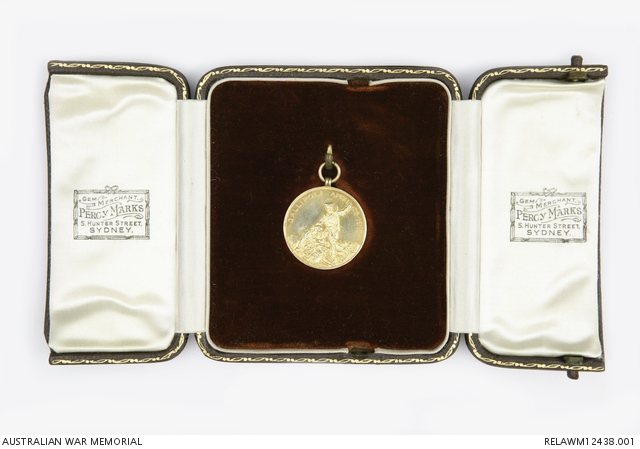| Place | Oceania: Australia |
|---|---|
| Accession Number | RELAWM12438.001 |
| Collection type | Heraldry |
| Object type | Medalet |
| Physical description | Gold, Leather, Silk, Velvet |
| Location | Main Bld: First World War Gallery: The Anzac Story: Gallipoli: The Grand Plan |
| Maker |
Amor Pty Ltd |
| Place made | Australia |
| Date made | 1915 |
| Conflict |
First World War, 1914-1918 |
Australia Day gold commemorative Gallipoli medalet : Mrs E Wharton-Kirke




Gold medalet struck in 1915. The obverse depicts a soldier, arm raised, with a wounded comrade, accompanied by the words 'GALLIPOLI APRIL 25 1915'. The reverse features a map of Australia under the words 'AUSTRALIA DAY'. There is a 9 ct gold stamp in the lower right corner of the map. The words 'FOR GOD, KING AND COUNTRY / REMEMBER THE DARDANELLES' appear around the circumference. Further words have been engraved concentrically inside this legend and read 'Pres to ELLIE WHARTON-KIRKE / BY / SYDNEY / CITIZENS 25.7.1915'.
Gold version of the Gallipoli medalet which is usually only encountered in either gilded or silvered bronze. Struck by Amor Badges of St Peters in mid July 1915, this was one of the first commemorative medallions to commemorate the Gallipoli landings. Thousands were produced, but only four solid gold versions were ever struck. They were presented to King George V, the Prince Of Wales, King Albert of Belgium and Mrs Ellen (Ellie) Wharton-Kirke, MBE of Manly, NSW.
This is Mrs Wharton-Kirke's medallion and displays the 'Australia Day' motto on the reverse which commemorates the fundraising event that she initiated. Noting the generous spirit of the Australian people, Mrs Wharton-Kirke suggested the concept to the Premier of NSW, William A Holman, of declaring Australia Day a national day for raising money for war charities. The idea was accepted, the date set for 30 July 1915. (Note that what we know as Australia Day, 26 January, was then known as Foundation Day and Australia Day was a new concept). Planning was supported at high levels. Mrs Wharton-Kirke notes 'Lady Edeline Strickland helped me considerably by allowing me to hold my meetings at her home, Government House.'
The Official History (Vol XI, p 728-9) notes 'The period succeeding the Landing was for the most part a gloomy one. But as events at Gallipoli quickened the process of enlistment, so they lent spirit to a general and splendid process of giving.' Photographs and descriptions of the 1915 Australia Day show an overwhelming display of public support for the event. 'It is unlikely that Australia Day will ever be wholly forgotten by any who were privileged to take part in that magnificent outburst of giving,' noted the Official History, 'In Sydney the Government co-operated with the promoters of Australia Day by transforming Martin Place into a fairyland ... dozens of little cabins and booths, specially constructed, served to display all kinds of goods, from embroideries and laces to potatoes and pickles ... Bevies of girls in various fancy or national costumes, brought their battery of charms to bear upon the men. Bands of musicians perambulated the streets and gave open-air concerts. As the hours went on, the crowds, the excitement, the liberality of all sorts and conditions of persons increased and, when the exquisite winter day closed in, it was evident that the people, having 'made a day of it', were intent on making a night of it too. It seemed as if the whole community had abandoned itself to giving and spending all it had for the sake of the men on service.'
Indeed, The Sydney Morning Herald noted that the first cheque handed to Mrs Wharton-Kirke was for ten thousand pounds. Australia Day was held in all states in 1915 and netted 839,550 pounds in NSW and 311,848 pounds in Victoria. The gold medallion was presented to Mrs Wharton-Kirke in recognition of her tireless efforts. Wharton-Kirke's only daughter (Mrs R M Lane) was similarly community minded and inaugurated the Belgian Babies' Milk Fund of Australia (for which Belgium awarded her the Royal Decoration of Queen Elizabeth), as well as equipping and sending to France two field ambulances and a pair of travelling kitchens.
Wharton-Kirke's four sons served; the eldest Captain Errol Wharton Kirke, ANMEF and 18 Battalion, died on 4 August 1916. Lieutenant Hunter Wharton-Kirke (MC), 17 Battalion; 1806 Private Basil Everal Wharton-Kirke, AAMC, both returned to Australia. Clement Wharton-Kirke is noted and appears to have served with British forces. This medallion was donated to the Australian War Memorial by Mrs Wharton-Kirke at the 1936 Anzac Day ceremony at Manly. She presented it to the Mayor of Manly, who presented it to the Honourable Archdale Parkhill, Minister for Defence, representing the Memorial. The case in which it is stored was especially made for this occasion.